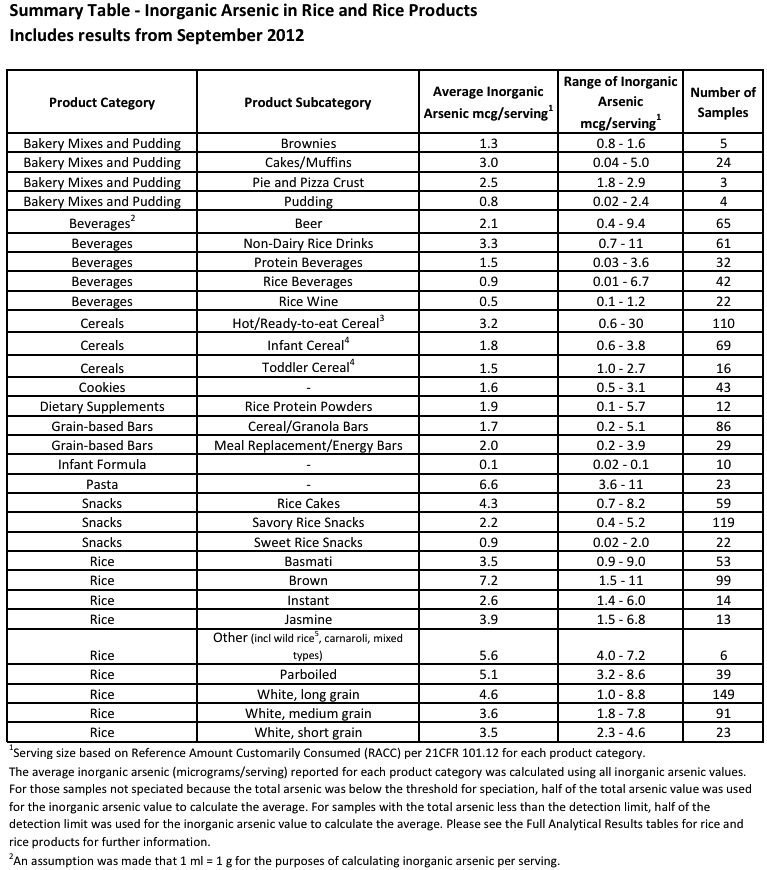FDA Tests Confirm Presence Of Arsenic In Rice Products
There are currently no federal limits on arsenic levels in most foods. New Jersey currently has the strictest state-level standard for arsenic in drinking water at 5 parts per billion, which would expose you to around 5 micrograms of arsenic per liter.
(NOTE: An earlier version of this post described this as 5 micrograms per serving; since one liter is significantly more water than the average person consumes at once, so 5 micrograms is the most New Jersey law would allow you to be exposed to while drinking about 4, 8-ounce glasses of water. And while some states have set maximum tolerance levels for arsenic, no level of inorganic arsenic can really be considered to be safe).
Of particular concern are levels of inorganic arsenic, as this form of the element is a known carcinogen tied to bladder, skin and lung cancer.
The chart below provides the average levels of arsenic for each of the 36 types of rice product tested by the FDA. The product with the lowest average level of inorganic arsenic was infant formula, at only .1 microgram per serving, while brown rice averaged the highest with 7.2 micrograms.
Other products with averages at or above 5 micrograms per serving (Again, that’s several times the NJ state limit for drinking water) were rice pasta (6.6 micrograms), parboiled rice (5.1), and an “other” category that includes so-called “wild rice,” which is not actually rice but an edible rice-like grain (5.6).
Long-grain white rice also averaged a high level of arsenic, with 4.6 micrograms per serving, as did rice cakes (4.3 micrograms).
Drilling down even further, this PDF shows the item-by-item breakdown for each tested product.
For example, while Basmati rice only averaged 3.5 micrograms per serving, 9 of the 53 products tested were above the 5 micrograms threshold, with two samples showing 9 micrograms of inorganic arsenic per serving.
Fifteen of the brown rice samples showed at least 9 micrograms of arsenic, with several going over 10 micrograms. Three of these samples actually had 11 micrograms per serving — the highest levels found in all of the testing. That peak level of 11 micrograms was also found in some non-dairy rice drinks and pasta.
The FDA claims that these levels of arsenic pose no risk for “immediate or short-term adverse health effects,” but this is also the agency that lets the food-packaging industry decide whether or not certain products are banned, and is okay with cigarette companies introducing new varieties of cancer-causing consumer products, so long as they’re virtually identical to what’s already on the market.
The agency say it will now conduct a risk assessment “considering how much arsenic is consumed from rice and rice products, and whether there are variations in health effects for certain segments of the population.” Given the snail-like speed of this process, don’t hold any hopes on seeing actual guidelines on arsenic in rice anytime soon.
At the same time as the FDA is telling everyone it’s cool to chow down on rice, it’s also advising consumers to vary their grains, and encouraging consumers to check ingredients lists to see which products contain rice in some form (hint: lots of them)
Dr. Urvashi Rangan, Director of Consumer Safety and Sustainability at Consumer Reports says that the FDA’s “no short-term harm” message misses the point of these studies and distracts from the bigger concern of the long-term health effects of arsenic exposure.
“The issue is not the short-term risks of rice consumption,” explains Dr. Rangan. “The concern is the long-term effects from exposure to arsenic in rice. As Consumer Reports has said in the past, consumers should not ignore the potential risks from consuming rice and rice products over a long period of time. That’s why it is important that the FDA announced today that it is going to do an assessment of the health risks associated with eating rice and rice products. The potent cancer-causing potential of inorganic arsenic is well established and based on lifetime exposure.
“Consumers are not well-served if they do not have the full story,” continues the doctor. “The concerns about long-term effects are significant and warrant the FDA’s decision to investigate further. The agency also put out advice today to consumers on how to vary the grains in their diets. This is especially important for vulnerable populations like infants and children.”
Consumer Reports continues to urge consumers to moderate their rice consumption. Consumers Union, the advocacy arm of Consumer Reports, has called for the FDA to set a standard for high-risk foods like rice.
Want more consumer news? Visit our parent organization, Consumer Reports, for the latest on scams, recalls, and other consumer issues.



